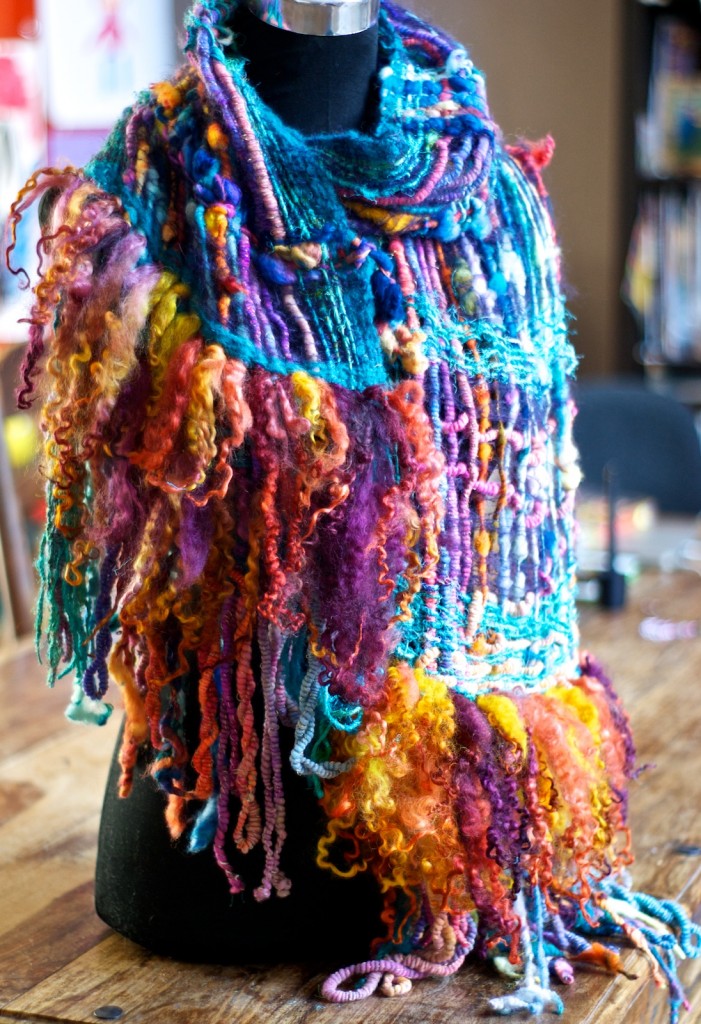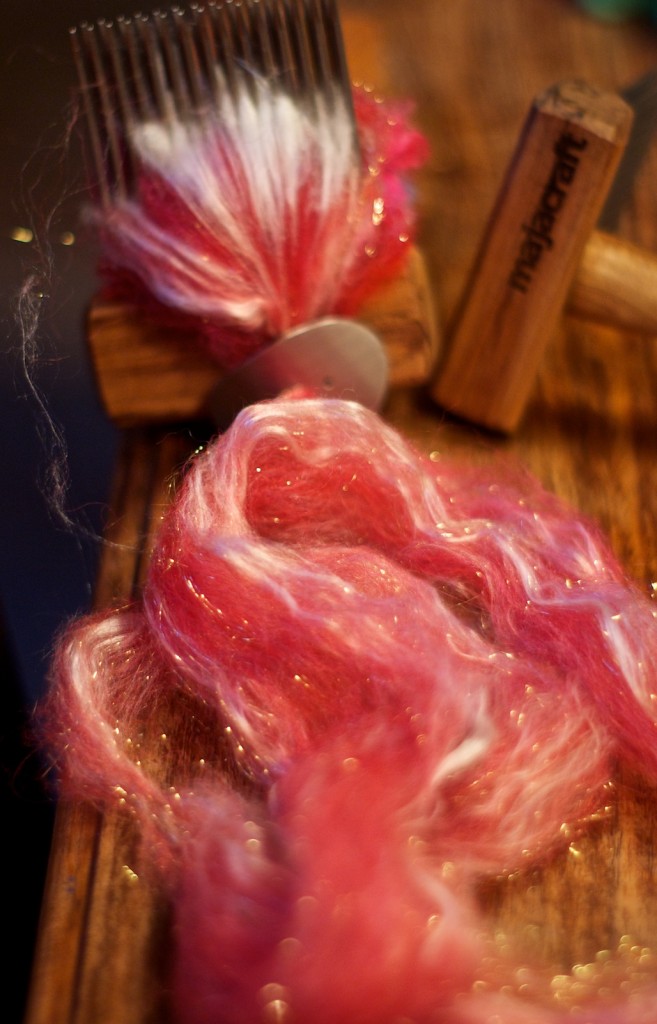Firstly, remember a while back Arlene surprised me with a wonderful woven treat? (I am still glowing!) So now, with my impending trip to the US and the much looked forward to hang out with Arlene between workshops, I thought it a great time to return the favour. I took this off the loom today, and it just needs washing and fulling and then it gets packed for the big flight across the water. I can’t wait to hand this to Arlene in person! This is one of the best things about our Journey to the Golden Fleece, sharing it with each other 🙂
And yes, most certainly some of the fibers in this weaving were prepared by me, with the help of my trusty diz. The focus of this weeks tool tip is the often overlooked and possibly undervalued Diz!
Many people know this as something you use with a hackle, a small object whose main value is the hole in the middle of it, used to draft the fiber through to make into roving or combed top. Usually used with the hackle or combs, this little disc may well be considered the ‘extra’ bit, the easily forgotten accessory, and in my house at least, regularly called the ‘where did I put it?’ object of frustration and subject of many searches.
However, the reason for this is simply because, in fact, the humble diz is a really indispensable tool! If we have no diz we have no roving! We are left with broad batts and hackles full of uselessly lashed fiber. Without that little circle of convenience we wouldnt have the gorgeous eye candy that inevitably happens on a hackle (see the last tool tip for that one!) and we would never enjoy the experience of spinning a batt that we have dizzed off the drum carder into a fluffy thick roving.
And guess what, you dont even need any other equipment to use a diz for colour blending! You can pick your fiber and hand mix some colours into a ‘cloud’ and then pull that through your diz to organise it into a spinable sliver.
But if you do have a hackle, are thinking of getting one, or looking at a set of lethally sharp weapons combs to set upon that pile of washed fiber.. here is an excerpt from our FiberyGoodness ebook on Colour Blending, and the soon to be released Colour Blending Course!
The method for dizzing fibre off the hackle or combs:
First, take a pinch of fibre from one side of the hackle or comb, give it a little twist to make a point, and slide it through the hole in the diz. Don’t take too much fibre because that will jam up the diz and you wont be able to draft your fibre through it, you will know its too much because it will jam…
Take the tip of that fibre then gently slide the diz along it towards the hackle or comb tines, stop when you get a bit of resistance – and again, don’t push it too hard into the fibres as you will collect too much through the hole and it will jam.
Now gently pull your fibres through the diz, you should feel them drafting out a little. If you pull too hard it will break off, so as soon as you feel the fibres starting to pull apart and your diz becomes loose on the fibres, then its time to push it up again gently to collect more. It’s a good idea to draft your fibres side to side, rather than tugging them straight out, this will help you keep a better thickness and evenness in your roving, as well as making it easier to draft.
Once you have drafted off most of the fibre in one area, start moving your diz across the front of the hackle slightly each time you push it back in to collect more fibre, the goal is to work your way across the entire width of the hackle (or comb), picking up and drafting the fibre through the diz to make a continuous roving. Don’t worry if you get thin bits though, or if it breaks off, you can still spin it in pieces, and it can take quite a bit of practice to get a ‘perfect’ roving. If you are taking the fibre from the comb, you will get shorter lengths, roll them up into little nests and store them in a basket until you are ready to spin, they are incredibly decorative!
For a demonstration of dizzing from a hackle here is my blending video:


While a beautiful diz us a pleasure to own, o often use a fender washer as a diz – they are sturdy, cheap…and its no big deal if you misplace it, as you can get several more for $1 at any hardware store.
Absolutely stunning!!
I love DIZ… Though I prone to call it TIZ… Hackle, combs, drum carder, blending board to “lap diz”
Thanks for a great article. I usually use fender washers but that brass DIZ is beautiful!
I’m working on this technique and I’m happy to say I’m getting better at it. I love the e-books for all the info it has given me for the blending techniques. Thanks Suzy
I was playing around with blending today, I wanted to try to diz off a cloud, but no diz. Which led to discovery – old credit cards make a wonderful diz with as many hole size options as you have drill bits!
I see happy clouds being pulled through my diz—- some time in the near future. (~:
I love the diz. I have been working on a budget, so I card with dog brushes and then stack a few of the carded sections and Diz from one end to the other, and I use the scratcher you can get from store that sell scratch lottery tickets. My roving is not as thick (dense) as store bought, but it makes spinning so much easier. I am going to make a diz and try different size holes to see if that has an effect on my roving. Good luck all and happy spinning!
Could this also be used to make same color rolag type things?